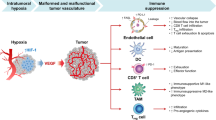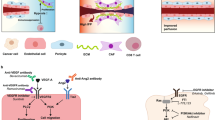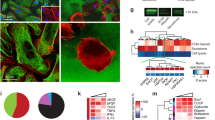Abstract
Immature and unstable tumor vasculature provides an aberrant tumor microenvironment and leads to resistance of tumors to conventional therapy. Hence, normalization of tumor vessels has been reported to improve the effect of immuno-, chemo- and radiation therapy. However, the humoral factors, which can effectively induce maturation of tumor vasculature, have not been elucidated. In this study, we found that the novel peptide apelin and its receptor APJ can induce the morphological and functional maturation of blood vessels in tumors. This apelin-induced tumor vascular maturation enhances the efficacy of cancer dendritic cell-based immunotherapy and significantly suppresses tumor growth by promoting the infiltration of invariant natural killer T cells into the central region of the tumor and thereby robustly inducing apoptosis of tumor cells. Additionally, we showed APJ expression to be enhanced in the tumor endothelium in comparison with normal-state endothelial cells. These findings provide a new target for tumor vascular-specific maturation, which is expected to improve the efficacy of conventional cancer therapies.
This is a preview of subscription content, access via your institution
Access options
Subscribe to this journal
Receive 50 print issues and online access
$259.00 per year
only $5.18 per issue
Buy this article
- Purchase on Springer Link
- Instant access to full article PDF
Prices may be subject to local taxes which are calculated during checkout






Similar content being viewed by others
References
Bergers G, Benjamin LE . (2003). Tumorigenesis and the angiogenic switch. Nat Rev Cancer 3: 401–410.
Bottaro DP, Liotta LA . (2003). Cancer: out of air is not out of action. Nature 423: 593–595.
Brossay L, Chioda M, Burdin N, Koezuka Y, Casorati G, Dellabona P et al. (1998). CD1d-mediated recognition of an alpha-galactosylceramide by natural killer T cells is highly conserved through mammalian evolution. J Exp Med 188: 1521–1528.
Cox CM, D'Agostino SL, Miller MK, Heimark RL, Krieg PA . (2006). Apelin, the ligand for the endothelial G-protein-coupled receptor, APJ, is a potent angiogenic factor required for normal vascular development of the frog embryo. Dev Biol 296: 177–189.
Dai T, Ramirez-Correa G, Gao WD . (2006). Apelin increases contractility in failing cardiac muscle. Eur J Pharmacol 553: 222–228.
Dickson PV, Hamner JB, Sims TL, Fraga CH, Ng CY, Rajasekeran S et al. (2007). Bevacizumab-induced transient remodeling of the vasculature in neuroblastoma xenografts results in improved delivery and efficacy of systemically administered chemotherapy. Clin Cancer Res 13: 3942–3950.
Dings RP, Vang KB, Castermans K, Popescu F, Zhang Y, Oude Egbrink MG et al. (2011). Enhancement of T-cell-mediated antitumor response: angiostatic adjuvant to immunotherapy against cancer. Clin Cancer Res 17: 3134–3145.
Eyries M, Siegfried G, Ciumas M, Montagne K, Agrapart M, Lebrin F et al. (2008). Hypoxia-induced apelin expression regulates endothelial cell proliferation and regenerative angiogenesis. Circ Res 103: 432–440.
Fujii S, Shimizu K, Kronenberg M, Steinman RM . (2002). Prolonged IFN-gamma-producing NKT response induced with alpha-galactosylceramide-loaded DCs. Nat Immunol 3: 867–874.
Fukuhara S, Sako K, Minami T, Noda K, Kim HZ, Kodama T et al. (2008). Differential function of Tie2 at cell–cell contacts and cell-substratum contacts regulated by angiopoietin-1. Nat Cell Biol 10: 513–526.
Gasparini G, Longo R, Toi M, Ferrara N . (2005). Angiogenic inhibitors: a new therapeutic strategy in oncology. Nat Clin Pract Oncol 2: 562–577.
Gerber HP, Ferrara N . (2005). Pharmacology and pharmacodynamics of bevacizumab as monotherapy or in combination with cytotoxic therapy in preclinical studies. Cancer Res 65: 671–680.
Gerhardt H, Betsholtz C . (2003). Endothelial-pericyte interactions in angiogenesis. Cell Tissue Res 314: 15–23.
Heath VL, Bicknell R . (2009). Anticancer strategies involving the vasculature. Nat Rev Clin Oncol 6: 395–404.
Hurwitz H, Fehrenbacher L, Novotny W, Cartwright T, Hainsworth J, Heim W et al. (2004). Bevacizumab plus irinotecan, fluorouracil, and leucovorin for metastatic colorectal cancer. N Engl J Med 350: 2335–2342.
Jain RK . (2005). Normalization of tumor vasculature: an emerging concept in antiangiogenic therapy. Science 307: 58–62.
June CH, Blazar BR, Riley JL . (2009). Engineering lymphocyte subsets: tools, trials and tribulations. Nat Rev Immunol 9: 704–716.
Kakimi K, Guidotti LG, Koezuka Y, Chisari FV . (2000). Natural killer T cell activation inhibits hepatitis B virus replication in vivo. J Exp Med 192: 921–930.
Kälin RE, Kretz MP, Meyer AM, Kispert A, Heppner FL, Brändli AW . (2007). Paracrine and autocrine mechanisms of apelin signaling govern embryonic and tumor angiogenesis. Dev Biol 305: 599–614.
Kasai A, Shintani N, Kato H, Matsuda S, Gomi F, Haba R et al. (2008). Retardation of retinal vascular development in apelin-deficient mice. Arterioscler Thromb Vasc Biol 28: 1717–1722.
Kasai A, Shintani N, Oda M, Kakuda M, Hashimoto H, Matsuda T et al. (2004). Apelin is a novel angiogenic factor in retinal endothelial cells. Biochem Biophys Res Commun 325: 395–400.
Kawamata Y, Habata Y, Fukusumi S, Hosoya M, Fujii R, Hinuma S et al. (2001). Molecular properties of apelin: tissue distribution and receptor binding. Biochim Biophys Acta 1538: 162–171.
Kawano T, Cui J, Koezuka Y, Toura I, Kaneko Y, Motoki K et al. (1997). CD1d-restricted and TCR-mediated activation of valpha14 NKT cells by glycosylceramides. Science 278: 1626–1629.
Kawano T, Nakayama T, Kamada N, Kaneko Y, Harada M, Ogura N et al. (1999). Antitumor cytotoxicity mediated by ligand-activated human V alpha24 NKT cells. Cancer Res 59: 5102–5105.
Kidoya H, Naito H, Takakura N . (2010). Apelin induces enlarged and nonleaky blood vessels for functional recovery from ischemia. Blood 115: 3166–3174.
Kidoya H, Ueno M, Yamada Y, Mochizuki N, Nakata M, Yano T et al. (2008). Spatial and temporal role of the apelin/APJ system in the caliber size regulation of blood vessels during angiogenesis. EMBO J 27: 522–534.
Kim KJ, Li B, Winer J, Armanini M, Gillett N, Phillips HS et al. (1993). Inhibition of vascular endothelial growth factor-induced angiogenesis suppresses tumour growth in vivo. Nature 362: 841–844.
Kunii N, Horiguchi S, Motohashi S, Yamamoto H, Ueno N, Yamamoto S et al. (2009). Combination therapy of in vitro-expanded natural killer T cells and alpha-galactosylceramide-pulsed antigen-presenting cells in patients with recurrent head and neck carcinoma. Cancer Sci 100: 1092–1098.
Lago F, Dieguez C, Gomez-Reino J, Gualillo O . (2007). The emerging role of adipokines as mediators of inflammation and immune responses. Cytokine Growth Factor Rev 18: 313–325.
Lambrecht NW, Yakubov I, Zer C, Sachs G . (2006). Transcriptomes of purified gastric ECL and parietal cells: identification of a novel pathway regulating acid secretion. Physiol Genomics 25: 153–165.
Lohela M, Bry M, Tammela T, Alitalo K . (2009). VEGFs and receptors involved in angiogenesis versus lymphangiogenesis. Curr Opin Cell Biol 21: 154–165.
Masri B, Morin N, Cornu M, Knibiehler B, Audigier Y . (2004). Apelin (65-77) activates p70 S6 kinase and is mitogenic for umbilical endothelial cells. FASEB J 18: 1909–1911.
Motohashi S, Nagato K, Kunii N, Yamamoto H, Yamasaki K, Okita K et al. (2009). A phase I–II study of alpha-galactosylceramide-pulsed IL-2/GM-CSF-cultured peripheral blood mononuclear cells in patients with advanced and recurrent non-small cell lung cancer. J Immunol 182: 2492–2501.
Nieda M, Nicol A, Koezuka Y, Kikuchi A, Lapteva N, Tanaka Y et al. (2001). TRAIL expression by activated human CD4(+)V alpha 24NKT cells induces in vitro and in vivo apoptosis of human acute myeloid leukemia cells. Blood 97: 2067–2074.
Nieda M, Okai M, Tazbirkova A, Lin H, Yamaura A, Ide K et al. (2004). Therapeutic activation of Valpha24+Vbeta11+ NKT cells in human subjects results in highly coordinated secondary activation of acquired and innate immunity. Blood 103: 383–389.
Padera TP, Stoll BR, Tooredman JB, Capen D, di Tomaso E, Jain RK . (2004). Pathology: cancer cells compress intratumour vessels. Nature 427: 695.
Rosenberg SA, Lotze MT, Yang JC, Aebersold PM, Linehan WM, Seipp CA et al. (1989). Experience with the use of high-dose interleukin-2 in the treatment of 652 cancer patients. Ann Surg 210: 474–484; discussion 484–475.
Rosenberg SA, Restifo NP, Yang JC, Morgan RA, Dudley ME . (2008). Adoptive cell transfer: a clinical path to effective cancer immunotherapy. Nat Rev Cancer 8: 299–308.
Seaman S, Stevens J, Yang MY, Logsdon D, Graff-Cherry C, St Croix B . (2007). Genes that distinguish physiological and pathological angiogenesis. Cancer Cell 11: 539–554.
Seino K, Fujii S, Harada M, Motohashi S, Nakayama T, Fujisawa T et al. (2005). Valpha14 NKT cell-mediated antitumor responses and their clinical application. Springer Semin Immunopathol 27: 65–74.
Shin T, Nakayama T, Akutsu Y, Motohashi S, Shibata Y, Harada M et al. (2001). Inhibition of tumor metastasis by adoptive transfer of IL-12-activated Valpha14 NKT cells. Int J Cancer 91: 523–528.
Singh AK, Wilson MT, Hong S, Olivares-Villagomez D, Du C, Stanic AK et al. (2001). Natural killer T cell activation protects mice against experimental autoimmune encephalomyelitis. J Exp Med 194: 1801–1811.
Smyth MJ, Crowe NY, Pellicci DG, Kyparissoudis K, Kelly JM, Takeda K et al. (2002). Sequential production of interferon-gamma by NK1.1(+) T cells and natural killer cells is essential for the antimetastatic effect of alpha-galactosylceramide. Blood 99: 1259–1266.
Sorhede Winzell M, Magnusson C, Ahren B . (2005). The apj receptor is expressed in pancreatic islets and its ligand, apelin, inhibits insulin secretion in mice. Regul Pept 131: 12–17.
Sorli SC, Le Gonidec S, Knibiehler B, Audigier Y . (2007). Apelin is a potent activator of tumour neoangiogenesis. Oncogene 26: 7692–7699.
Spada FM, Koezuka Y, Porcelli SA . (1998). CD1d-restricted recognition of synthetic glycolipid antigens by human natural killer T cells. J Exp Med 188: 1529–1534.
Steinman RM, Banchereau J . (2007). Taking dendritic cells into medicine. Nature 449: 419–426.
Takakura N, Watanabe T, Suenobu S, Yamada Y, Noda T, Ito Y et al. (2000). A role for hematopoietic stem cells in promoting angiogenesis. Cell 102: 199–209.
Taniguchi M, Harada M, Kojo S, Nakayama T, Wakao H . (2003). The regulatory role of Valpha14 NKT cells in innate and acquired immune response. Annu Rev Immunol 21: 483–513.
Tatemoto K, Hosoya M, Habata Y, Fujii R, Kakegawa T, Zou MX et al. (1998). Isolation and characterization of a novel endogenous peptide ligand for the human APJ receptor. Biochem Biophys Res Commun 251: 471–476.
Willett CG, Kozin SV, Duda DG, di Tomaso E, Kozak KR, Boucher Y et al. (2006). Combined vascular endothelial growth factor-targeted therapy and radiotherapy for rectal cancer: theory and clinical practice. Semin Oncol 33: S35–S40.
Yamada Y, Takakura N . (2006). Physiological pathway of differentiation of hematopoietic stem cell population into mural cells. J Exp Med 203: 1055–1065.
Acknowledgements
We thank Ms C Takeshita, Ms K Fukuhara and Ms N Fujimoto for technical assistance. Financial support: This work was supported by Grant-in-Aid for Research Activity Start-up (KAKENHI 21890124) from the Japan Society for the Promotion of Science (JSPS) and Research; a grant from the Ministry of Education, Culture, Sports, Science and Technology (MEXT) of Japan; and the YASUDA Medical Foundation.
Author information
Authors and Affiliations
Corresponding author
Ethics declarations
Competing interests
The authors declare no conflict of interest.
Additional information
Supplementary Information accompanies the paper on the Oncogene website )
Supplementary information
Rights and permissions
About this article
Cite this article
Kidoya, H., Kunii, N., Naito, H. et al. The apelin/APJ system induces maturation of the tumor vasculature and improves the efficiency of immune therapy. Oncogene 31, 3254–3264 (2012). https://doi.org/10.1038/onc.2011.489
Received:
Revised:
Accepted:
Published:
Issue Date:
DOI: https://doi.org/10.1038/onc.2011.489
Keywords
This article is cited by
-
Adipo-oncology: adipocyte-derived factors govern engraftment, survival, and progression of metastatic cancers
Cell Communication and Signaling (2024)
-
Apelin is associated with clinicopathological parameters and prognosis in breast cancer patients
Archives of Gynecology and Obstetrics (2022)
-
Apelin-driven endothelial cell migration sustains intestinal progenitor cells and tumor growth
Nature Cardiovascular Research (2022)
-
Endothelial cell-derived Apelin inhibits tumor growth by altering immune cell localization
Scientific Reports (2021)
-
Apelin promotes blood and lymph vessel formation and the growth of melanoma lung metastasis
Scientific Reports (2021)



